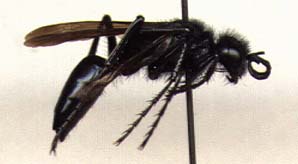Members of this genus are considered to be more primitive than those of Ammophila. Podalonia typically prey on soil-dwelling noctuid larvae (cutworms) and excavate a shallow, one-celled nest after capturing prey. (Most sphecids excavate the burrow before capturing prey). The caterpillar is usually cached on a clump of vegetation while the wasp digs her burrow. Only one prey is used per nest. The apparently one-segmented petiole is perhaps the easiest character for separating Podalonia from Ammophila and Eremnophila. The biology and systematics of the genus have been reviewed by Bohart and Menke (1976).
Podalonia luctuosa (Smith) 1856. Podalonia
luctuosa is a transmontane and boreal North American species that
is probably widespread in Michigan. The females are the only
all-black Podalonia east of the Rocky Mountains. Another
all-black species, Podalonia atriceps (Smith) (formerly known
as P. communis (Cr.)), is found throughout the western US and
into Costa Rica (Menke, 1996). Its exact relationship to P.
luctuosa is not clear.
BIOLOGY: Females emerge from hibernation in late April to
early May and begin nesting during warm, sunny days. This species
is bivoltine, and a variety of cutworm
species have been recorded as prey (O'Brien and Kurczewski 1982).
Females of the second generation mate in late summer and dig deep,
overwintering burrows which they
enter in the fall, with several wasps often sharing a burrow (O'Brien
and Kurczewski 1982). Steiner (1983) has studied the hunting and
stinging behavior of P. Iuctuosa under laboratory conditions.
FLOWER RECORDS: Achillea millefolium, Barberea vulgaris,
Cerastium vulgatum, Chrysanthemum leucanthemum, Daucus carota,
Erigeron canadensis, Fragaria virgini ana, Hypericum perforatum,
Lepidium virginicum, Melilotus alba, Potentilla recta, Solidago spp.,
Taraxacum offcinale, Trifolium agrarium, T. pratense, T. repens.
COLLECTION DATES: 180 specimens, 16 April to 3 October.
Due to the hibernation of adult females, and the two generations (in
most cases), there are three adult peak appearances: May, early July,
and late August to early September. The males generally peak in late
June to early July, and in mid-August.

![]() BACK to Main Page
BACK to Main Page